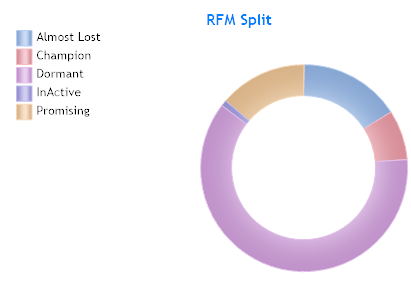RFM Status Indicators
RFM Status Indicators for CRM

RFM stands for Recency, Frequency, and Monetary value. It’s a method used in customer relationship management (CRM) to analyse customer behaviour and determine who your best customers are based on three key dimensions:
- Recency (R): How recently a customer made a purchase. Customers who purchased more recently are more likely to engage with your business.
- Frequency (F): How often a customer makes a purchase. Frequent customers are valuable as they contribute more to sales.
- Monetary (M): How much money a customer spends. Higher monetary value indicates greater importance to the business.
By calculating these rankings the system can classify all customers into the following Status indicators;
Champions:
- Definition: Customers who have made recent purchases, buy often, and spend the most.
- Characteristics: Highly engaged; often respond positively to marketing and loyalty campaigns.
Loyal Customers:
- Definition: Customers who frequently buy and have a good spending level, but may not have made a recent purchase.
- Characteristics: Valuable for retention, but may need re-engagement strategies to bring them back.
Active Customers:
- Definition: Recent purchasers who are active but may not have the highest spending or purchase frequency.
- Characteristics: Potential for upselling or cross-selling, often receptive to special offers.
Promising:
- Definition: Customers with moderate levels of purchasing and spending who show patterns indicating they might become more engaged.
- Characteristics: Recent engagement indicates potential; they may just need encouragement to buy again.
Needs Attention:
- Definition: Customers who have not purchased recently but show regular purchase patterns.
- Characteristics: At risk of lapse; strategies should focus on reminders, offers, or targeted marketing to reignite interest.
Almost Lost:
- Definition: Infrequent purchasers who spend some money but show signs of drifting away.
- Characteristics: Requires immediate marketing intervention to prevent complete churn.
At Risk:
- Definition: Customers who initially showed high engagement but have not purchased recently.
- Characteristics: Likely to churn; targeted re-engagement efforts are crucial.
Dormant:
- Definition: Customers who have not engaged or purchased for a long time.
- Characteristics: Considered lost; revitalisation efforts may yield low ROI.
Previously Loyal:
- Definition: Customers who were once engaged and spent well but have significantly dropped off.
- Characteristics: Important to identify and may require special tactics to win back.
How Does RFM Work?
- Data Collection: Collect data on customer transactions over a defined period.
- Scoring:
- Assign scores on a scale of 1 to 5 for each RFM factor based on data analysis.
- Calculate RFM values for each customer by combining these scores.
- Segmentation: Group customers based on their RFM scores. For example, customers with high scores in all three categories are considered your most valuable customers.
How Can RFM Be Used?
Filtering by RFM status allows you to focus on specific groups of customers. For example, you might want to target your most valuable or most engaged customers for a marketing campaign, or identify inactive customers who may need re-engagement.
When you apply a filter using the RFM status markers, the system will include only the records that match the selected RFM categories. This makes reporting, analysis, and targeted actions more precise and relevant.
- Targeted Marketing: Identify the best customers for specific marketing campaigns, promotions, or loyalty programs.
- Customer Retention: Focus retention efforts on customers who may be at risk of churn based on their recency score.
- Resource Allocation: Allocate resources effectively by concentrating efforts on high-value customer segments.
- Performance Measurement: Monitor changes in RFM scores over time to measure customer engagement and the effectiveness of marketing strategies.
RFM ranking is a powerful tool in CRM that can significantly enhance customer understanding and marketing efforts. By analysing and segmenting customers based on their behaviour, businesses can improve customer retention and drive sales effectively.